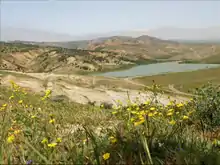Maghrawa
The Maghrawa or Meghrawa were a large Zenata Berber tribal confederation whose cradle and seat of power was the territory located on the Chelif in the north-western part of today's Algeria, bounded by the Wansharis to the south, the Mediterranean to the north and Tlemcen to the west.[1] They ruled these areas on behalf of the Umayyad Caliphate of Cordoba in the end of the 10th century and the first half of the 11th century.
Etymology and root

The Maghrawa descend from the branch of Madghis (Medghassen). The Maghrawa are the brothers of the Banu Ifran and the Irnyan. Ifren, Irnyan are the brothers of Maghra. The plural of Maghra is Aimgharen in Berber (which means "someone who has sold his share" but also "old"). We will say also say Maghrawa in literary Arabic from the point of view of the historian of the Maghreb, Ibn Khaldun.[2]
There are several tribes from the Maghrawa including Bani bou Said, Bani Ilit (Ilent), Bani Zendak, Bani Urac (Urtezmir, Urtesminn), Bani Urcifan, Bani Laghouat, Bani Righa, Bani Sidi Mansour (Bani Mansour),[3] A. Lahsen,[4] etc.
Most of the inhabitants of the Aurès are from this ancient tribe.[2] The Ouarsenis is home to the Maghraouas,[5] as well as the inhabitants of the Blidéen Atlas, the Dahra Range in Tipaza, Cherchell, Algiers, Ténès, Miliana, Mostaganem, Mazouna, etc.
Around the beginning of the first century. The Maghrawa were very numerous in the surroundings of Icosium (Algiers) and Ptolemy of Mauritania must have contained them. Ptolemy will transfer a part of the Maghrawa towards the Chlef region.[6]
Among the tribes of Maghrawa ancestry and masters of the Western Dahra in the nineteenth century, there were: the Achaachas, the Zerrifas, the Ouled Khellouf (where the mausoleum of the marabout Sidi Lakhdar is located), the Beni Zeroual and the Mediounas, most of them are communes of the wilaya of Mostaganem.
History
The confederation of Maghrawa actively participated in the various events of ancient life. They are the majority people of the central Maghreb among the Zenets (Gétules). Both nomadic and sedentary, the Maghrawa lived under the command of Maghrawa chiefs or Zenata. Algiers has been the territory of the Maghrawa since ancient times.[6] The name Maghrawa will be transcribed into Greek by historians. The great kingdom of the Maghrawa is located between Algiers, Cherchell, Ténès, Chlef, Miliana and Médéa. Ptolemy moved part of the Maghrawa to Chlef.[6] The Maghrawa impose their domination in the Aurès.[7] Chlef and its surroundings were populated by the Maghrawa according to Ibn Khaldun.[2] The Maghrawa settled and extended their domination throughout the Dahra and beyond Miliana to the Tafna wadi in the vicinity of Tlemcen, we find them as far as Mali.
The Meghrawa, a tribe of Zanata Berbers,[2] were one of the first Berber tribes to submit to Islam in the 7th century. They supported Uqba ibn Nafi in his campaign to the Atlantic in 683. They defected from Sunni Islam and became Kharijites Muslims from the 8th century, and allied first with the Shia Muslim Idrisids, and, from the 10th century, with the Andalusian Umayyads of Córdoba. As a result, they were caught up in the Umayyad-Fatimid conflict in Morocco and Algeria. Although they won a victory over the allies of the Fatimids in 924, they soon became allied with them themselves. When they switched back to the side of Córdoba, they were driven out of central Morocco by the Zirids, who ruled on behalf of the Fatimids. In 980, however, they were able to drive the Miknasa out of Sijilmasa.[2]
Under Ziri ibn Atiyya (to 1001) the Meghrawa achieved supremacy in Fez under Umayyad suzerainty and expanded their territory at the expense of the Banu Ifran. A revolt against the Andalusian Umayyads was put down by Al-Mansur (Abi Amir), although the Meghrawa were able to regain power in Fez. Under the succeeding rulers al-Muizz (1001-1026), Hamman (1026-1039) and Dunas (1039) they consolidated their rule in northern and central Morocco. However, internal power struggles after 1060 enabled the Almoravid dynasty to conquer the Maghrawa realm in 1070 and put an end to their rule.
Maghrawid leaders
- Mohamed Ibn Al Khayr 970.
- Attia 986 - 988.[8]
| Preceded by Idrissid and Umayyad dynasty |
Maghrawas 970-1068 |
Succeeded by Almoravid dynasty |
References
- Lewicki, T. (24 Apr 2012). "Mag̲h̲rāwa". Brill.
- Ibn Khaldoun , History of berber
- Émile-Félix, Gautier (1910). La conquête du Sahara: essai de psychologie politique. A. Colin. p. 141.
- Bellil, Rachid. (1999). Les oasis du Gourara (Sahara algérien). Institut national des langues et civilisations orientales. Centre de recherche berbère. Paris: Éditions Peeters (Études berbères). ISBN 2-87723-420-7. OCLC 45966529.
- Le Correspondant (in French). Charles Douniol. 1864.
- Journal asiatique (in French). Société asiatique. 1884.
- Mercier, Ernest (1999-01-01). Histoire de l'Afrique Septentrionale (Berbérie) Depuis les Temps les Plus Reculés Jusqu'à la Conquête Française (1830) (in French). Adegi Graphics LLC. ISBN 978-1-4212-5345-9.
- Table made by Ibn Khaldun and translated by Slane indicating the dynasty Banou Ifran by Ibn Khaldun Book Google Ibn Khaldun , History of Berber
